#Jacopo Robusti Tintoretto
Explore tagged Tumblr posts
Text
Panie, czy Ci to obojętne…?!
Kolejny lipcowy dzień, kiedy słyszymy niejako z urzędu – Urzędu Nauczycielskiego Kościoła o kolejnej wspaniałej kobiecie z Ewangelii.Jest nią Marta – siostra Marii i Łazarza. Dlaczego wspaniała? Myślę, że Marta jest niedoceniana, a przecież troszczy się o dom, o posiłek o sprawy doczesne, które są przecież bardzo ważne. Ale nic w tym dziwnego większość normalnych kobiet na całym świecie o to się…

View On WordPress
#Augustyn z Hippony#Bernard z Clairvaux#Cyryl Aleksandryjski#Diego Velazquez#Grzegorz Wielki#Henryk Siemiradzki#Jacopo Robusti Tintoretto#Jan Brueghel II#Jan Paweł II Wielki#Katarzyna ze Sieny#Maria i Marta z Betanii#Mistrz Eckhart#Rubens#Teresa z Avila#Tomasz z Akwinu#św. Jan Chryzostom
0 notes
Text

Self-Portrait by Jacopo Robusti, called Il Tintoretto
Italian, c. 1546-1548
oil on canvas
Philadelphia Museum of Art
#self-portrait#portrait#Renaissance#Tintoretto#Jacopo Robusti#still can't decide if I should just go with Tintoretto instead#art#Italian#Venetian#painting#Mannerism#Venetian School#Philadelphia Museum of Art
237 notes
·
View notes
Text

1555 Jacopo Robusti (Tintoretto) - Portrait of a young man
(Barber Institute of Fine Arts)
148 notes
·
View notes
Text
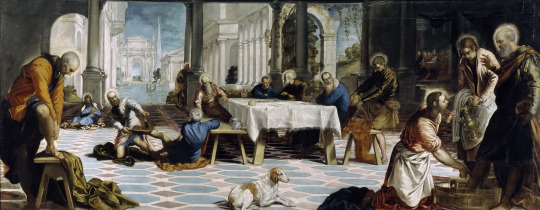
Jacopo Robusti 'Tintoretto' (Italian, 1518-1594) The Washing of the Feet, ca.1548-49 Museo Nacional del Prado This scene from the New Testament (John 13, 1-20) shows the moment just before the Last Supper, when Jesus washed Saint Peter´s feet as an example of humility and service to others.
#Jacopo Robusti#tintoretto#italian art#christian art#art#fine art#european art#classical art#europe#european#oil painting#fine arts#europa#mediterranean#italy#italian#southern europe#christian#christianity#catholic#catholic art#catholicism#roman catholic#western civilization
53 notes
·
View notes
Text

Home of Tintoretto in Cannaregio, Venezia, Italy
7 notes
·
View notes
Text

Latona transforms the Lycian peasants into frogs, Tintoretto
#latona#leto#tintoretto#Palazzo dei Musei#modena#Jacopo Robusti#roman mythology#greek mythology#greek myth#mannerist#mannerism#greek gods
17 notes
·
View notes
Photo
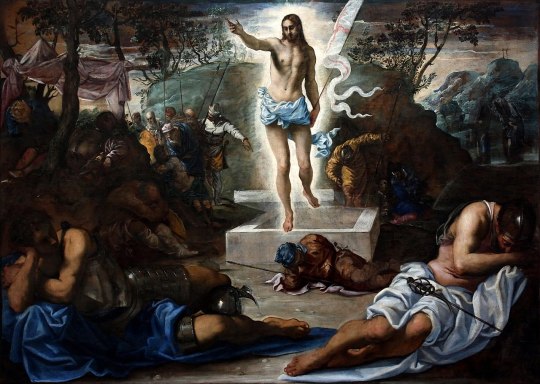
Jacopo Tintoretto: La Resurrezione
#Tintoretto#Jacopo Tintoretto#Jacopo Robusti#La Resurrezione#The Resurrection of Christ#Oil on Canvas#Painting#Art#Mannerism#Rennaissance#Religious Art#Sacred Art#Christian Art
26 notes
·
View notes
Text

Tintoretto (Jacopo Robusti) (Italian, 1518-1594) - Coronation of the Virgin (Paradise) (c. 1564)
Oil on canvas, 56.25 x 142.5 in. (143 x 362 cm)
0 notes
Text
A black-and-white chalk drawing of the head of a portly man was recently sold at a Christie’s auction as the only work firmly attributed to Marietta Robusti, daughter of the Venetian master Jacopo Robusti, perhaps better known as Tintoretto. Reports from her contemporary biographers suggest that Marietta, who worked in her father’s workshop in the late 16th century, was an accomplished and sought-after artist in her own right. But in the centuries that followed she fell into obscurity. Now, amid a growing movement to reclaim the women artists so often neglected by history, Marietta has the potential to join 16th-century peers such as Lavinia Fontana and Sofonisba Anguissola in the history books – if only researchers could find some more of her work.
‘Marietta had a brilliant mind like her father. She painted such works that men were astonished by her talent,’ writes Carlo Ridolfi, author of a biography of Jacopo Tintoretto and two of his children, Domenico and Marietta, first published in 1642. Nicknamed ‘La Tintoretta’, Marietta – who, according to Ridolfi, dressed as a boy in order to assist her father on his projects – is recorded as having painted many portraits and produced works of her own invenzione. Another of Tintoretto’s early biographers, Raffaello Borghini, reports how Marietta was requested as a court artist by the Holy Roman Emperor Maximilian II, Archduke Ferdinand of Austria, and King Philip II of Spain – although ‘Greatly loving his daughter, [Tintoretto] did not want her taken from his sight,’ writes Borghini.
With such glowing accounts of Marietta’s artistic prowess, attempts to rediscover her work have been numerous and in some cases quite inventive. Unfortunately, these endeavours have rarely been successful.
One of the most commonly attributed paintings is a Self-Portrait with Madrigal located in the Uffizi’s Corridoio Vasariano in Florence. The painting shows a young woman in a white dress with her right arm resting on a harpsichord behind her and a music score in the other hand. The Uffizi labels the work as by Marietta Robusti in its online catalogue. However, art historians have questioned the credibility of this attribution based on provenance records, which show that the portrait was attributed to Titian by a Venetian collector in the 17th century.
Most damning of all, though, is the mediocrity of the painting. The art historian Joanna Woods-Marsden comments in her book Renaissance Self-Portraiture (1998) that the rudimentary foreshortening and poor anatomy are hard to reconcile with the praise lauded on Marietta by her biographers. Duncan Bull, writing in the Burlington Magazine in 2009, dismisses it as ‘a feeble work that speaks more of Verona than of Venice, let alone of Tintoretto’s workshop’. The lack of naturalism and the stiffness of the sitter are worlds away from the fluid, energetic style characteristic of a pupil of the Venetian master.
‘Marietta’s special gift,’ according to Ridolfi, ‘was knowing how to paint portraits well.’ This was not unusual praise for 16th-century women artists, who were highly valued as portraitists. Women were considered to have an eye for detail, particularly jewellery and decoration on clothing, which was so crucial in portraiture for demonstrating a sitter’s wealth and status.
Several portraits have been tentatively attributed to Marietta Robusti. These include a Portrait of an Old Man and a Boy in the Kunsthistorisches Museum in Vienna and the Rijksmuseum’s Portrait of Ottavio Strada. The attribution of the former painting rested on the signature ‘M R’ on the bottom left of the canvas; after cleaning, it appears that the signature actually reads ‘M 3’. The painting in Amsterdam, currently catalogued as by Jacopo Tintoretto, has received attention because Marietta’s early biographers mention a portrait she painted of the courtier Jacopo Strada. Some art historians argue that the biographers mistakenly cited Jacopo instead of his son Ottavio Strada – and that the Rijksmuseum’s painting is the portrait in question. But this is just one theory.
Plenty of historic catalogue entries attribute other work to Marietta, but evidence of these paintings is now thin on the ground. It is likely that Marietta also helped her father with public commissions, such as paintings in their local church in Venice, the Madonna dell’Orto. But her contributions in this respect are hard to pinpoint.
Just one drawing, therefore, is categorically attributed to Marietta. Head of man, after the antique, which sold at Christie’s in Paris last month for €100,000, depicts the Roman emperor Vitellius drawn from an ancient bust – a copy of which Tintoretto kept in his workshop. Scrawled across the drawing are the words ‘this head is by the hand of madonna Marietta’, probably added by her father to distinguish the drawing from the countless others that would have lain about the workshop.
This drawing is a much-needed example of Marietta’s talents. As Stijn Alsteens, international head of Christie’s Old Master drawings department explains to me via email, ‘Marietta in her time was admired as a portraitist, and the drawing can be said to reflect her interest in physiognomy.’ The drawing, Alsteens says, confirms Ridolfi’s account that Marietta was a gifted member of her father’s studio, on an equal footing with her male counterparts.
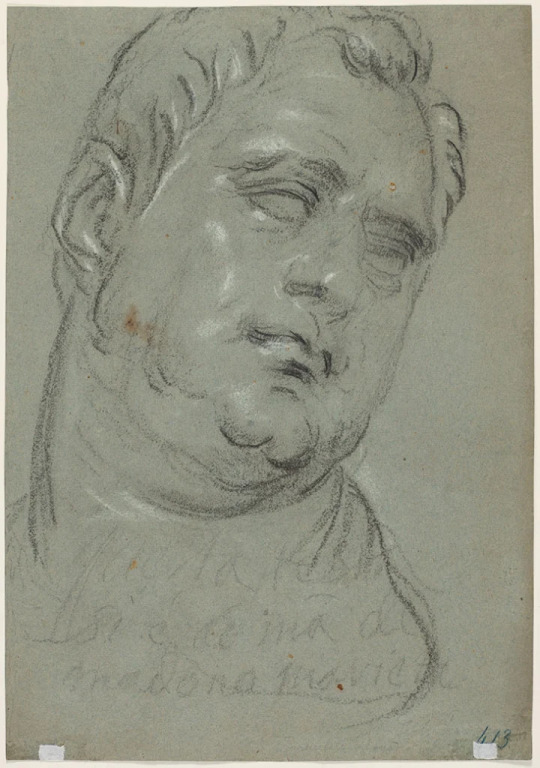
In the drawing, Marietta captures the head in soft, swift strokes, economic shading and dashes of highlights. We see the fluidity and movement expected of an artist trained by Tintoretto. On the recto of the sheet is another drawing from Tintoretto’s workshop of unknown attribution portraying the face of Giuliano de’ Medici. ‘Where the recto is mostly a study of light and shadow, the verso focuses on the distinctive features of Vitellius’s face – true to Marietta’s gifts as a portraitist,’ Hélène Rihal, head of Christie’s Old Master drawings department in Paris, said in advance of the sale.
Although the attribution is accepted, it is only one drawing and that poses a dilemma for anyone seeking to restore Marietta’s reputation. The historical evidence has the potential to put Marietta on a par with contemporaries like Fontana or Anguissola. The gaping hole is the physical evidence. For the moment La Tintoretta, the legendary woman artist, remains just that – a legend.
#studyblr#history#art#art history#portrait painting#feminism#italy#veneto#venice#cannaregio#madonna dell'orto#marietta robusti#jacopo robusti#tintoretto#carlo ridolfi#raffaello borghini#maximilian ii holy roman emperor#ferdinand ii archduke of austria#philip ii of spain#ottavio strada#jacopo strada#vitellius
1 note
·
View note
Photo

Die Agonie im Garten von Jacopo Robusti Tintoretto (oil on canvas)
#kunst#kunstwerk#art#artwork#jacopo robusti tintoretto#künstler#artist#religion#religiöse kunst#religious art#garten#garden#garten gethsemane#garden gethsemane#jesus christ#christus#christ#jesus#savior of the world#retter der welt#apostel#apostle#engel#angel#people#menschen#schlafen#sleeping#bibel#bible
11 notes
·
View notes
Text

The Muses by Jacopo Robusti, called Il Tintoretto
Italian, 1578
oil on canvas
Royal Collection Trust (acquired by King Charles I)
#Muses#mythology#Jacopo Robusti#Tintoretto#Italian#Venetian#art#painting#Royal Collection Trust#Renaissance#Mannerism
186 notes
·
View notes
Text

ab. 1547-1548 Jacopo Robusti (Tintoretto) - Portrait of a Young Man from the Renialme Family
(Fine Arts Museums of San Francisco)
88 notes
·
View notes
Text
Don’t you just hate it when a ship you hate has cute and gorgeous fanart?

Pierre Mignard

Sebastiano Ricci (y’know what maybe I’ll redraw one of these as Aglaia and Hephaestus just to be spiteful)

Jacopo Robusti Tintoretto

I especially like this one by Giulio Romano, Hephaestus making Eros’ arrows is pretty cute (also the erote playing with fire at the back lmao)
#greek mythology#ancient greek mythology#greek pantheon#hephaestus greek mythology#hephastios#hephaestus god#hephaestus#hephaistos#aphrodite greek mythology#aphrodite goddess#Aphrodite#hephaestus x aphrodite#aphrodite x hephaestus#classical art#renaissance art#shipping art
34 notes
·
View notes
Text

Tintoretto (Jacopo Robusti), 1519-1594)
Venus, Vulcan, and Cupid, ca.1550/55, oil on canvas
Palazzo Pitti
7 notes
·
View notes
Text
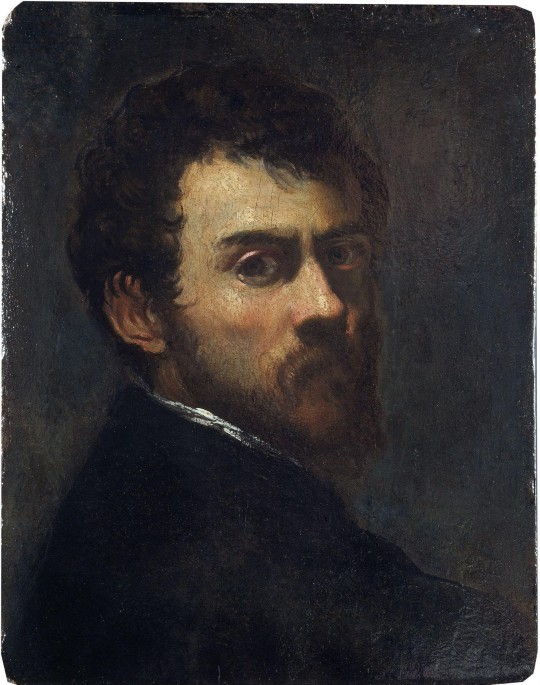
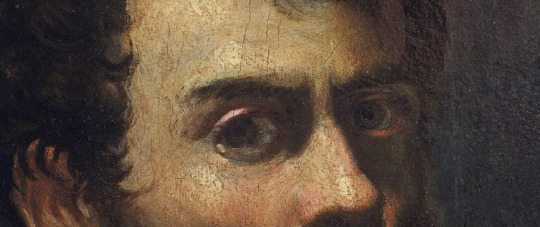
Self-portrait as a young man, Tintoretto (Jacopo Robusti), about 1548
#art history#art#italian art#painting#self portrait#tintoretto#16th century#rinascimento#venetian art#v&a museum#victoria and albert museum
12 notes
·
View notes